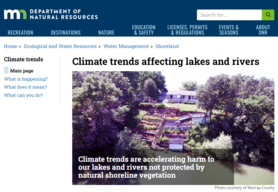
The DNR recently added a Climate trends affecting lakes and rivers page. Since climate trends are accelerating harm to our lakes and rivers, we explore:
- What is happening?
- What does it mean?
- What can you do?
Animations help tell the story
In the "What does it mean?" section are two series of animations showing the impacts of vegetation loss and development on shore erosion/flooding and on water quality.
|
 Scene at end for two of the water quality animations
More content will be added over time, and we welcome your suggestions for helpful information. Contact shoreland/rivers or floodplain staff with your ideas!
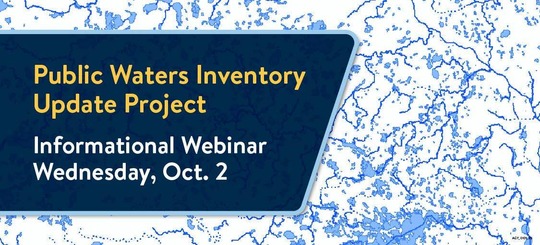 What are public waters? What is the project to update the Minnesota Public Waters Inventory?
Learn about which water bodies in Minnesota are defined as public waters that are regulated by the state. Also learn about the Public Waters Inventory (PWI) and the project to update the inventory.
When: 2-3 p.m. Wednesday, Oct. 2
Who: Open to all who are interested.
How to join:
- Link to Join
- Webinar number: 2486 954 6512
- Webinar password: PWIUpdate (79487328 when dialing from phone or video system)
Join by phone:
- +1-415-655-0003 United State Toll
- 1-855-282-6330 United State Toll Free
- Access code: 248 695 46512
For more information, see the DNR’s Public Waters Inventory Update Project webpage.
By Ceil Strauss, DNR, State Floodplain Manager
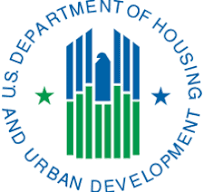
In response to the Federal Flood Risk Management Standards (FFRMS) requirements, the U.S. Department of Housing and Urban Development (HUD) has developed new rules which became effective April 23, 2024. The rules cover many areas, but this article focuses on updated requirements for the widely-used Federal Housing Administration (FHA) Single Family insured loans, or FHA loans. According to March 2024 data from the Mortgage Bankers Association, over 26% of all mortgage applications nationally for newly constructed homes were for FHA insured mortgages.
FAQ about new requirements to be eligible for FHA loans
-
What is the new requirement? The lowest floor of the building (including basement or crawl space) must be at least two feet above the Base Flood Elevation (BFE), commonly called the "100-year" floodplain. This is called the two-foot freeboard requirement. It is a resilience standard which applies to new construction, but not substantial improvement of existing buildings.
-
When does this requirement start? For any new construction with building permit applications submitted after Jan. 1, 2025.
-
Where does this requirement apply? Within the Special Flood Hazard Area (SFHA) on FEMA floodplain maps (called Flood Insurance Rate Maps, or Flood Hazard Boundary Maps). The SFHA includes A, AE, AO, AH and A# Zones, as well as V or VE Zones.
What is Minnesota's current lowest floor requirement?
Since 1970, Minnesota Rules have required the lowest floors (including basements and crawl spaces) to meet the Regulatory Flood Protection Elevation (RFPE), which is the BFE plus one foot of freeboard plus up to 0.5 feet of stage increase due to designating the floodway. So, buildings meeting just the current state minimum elevation requirement will not meet the new HUD requirements and will not be eligible for FHA loans.
Some communities in Minnesota have adopted higher standards and already require a two-foot or greater freeboard, and many communities have more restrictive ordinances and don't allow any new building construction in their floodplain. However, most have adopted the state minimum.
|
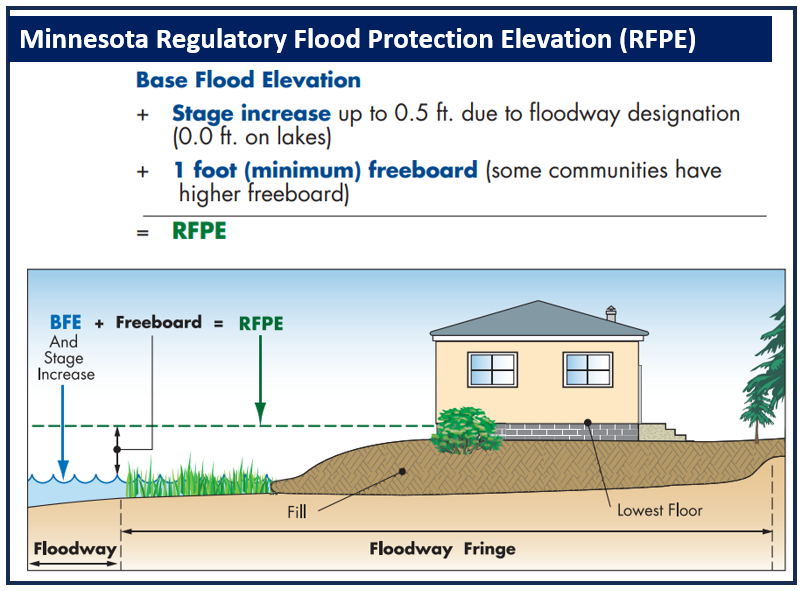 Minnesota's minimum Regulatory Flood Protection Elevation (RFPE) is BFE plus 1 to 1.5 feet.
What can/should communities do to ensure their residents are eligible for FHA loans?
If your community anticipates development in the FEMA mapped floodplain, there are both immediate and longer-term options that are encouraged.
Immediate: Communities can educate those proposing to build single family homes within their FEMA mapped SFHA (the "100-year floodplain") about the new HFA loan requirements and encourage them to meet the two-foot freeboard requirement.
Longer term: Communities can amend their floodplain management ordinance to require lowest floors of new buildings to meet the two feet above the BFE minimum requirement. This is highly encouraged so your residents can be eligible for FHA loans and to better reduce future flood damage.
Floodplain management ordinance amendment options:
-
Simple two-foot freeboard amendment - Communities can do a relatively simple amendment to their floodplain management ordinance to just update their RFPE to include the two-foot freeboard.
-
Adopt the latest Minnesota model ordinance and include the two-foot freeboard requirement - The state model floodplain management ordinance had a more major update in 2022 and 2023, adding graphics, clearer higher standard options, and some updates to better align the ordinance with state and federal regulations. If your community's ordinance is older than 2022, an updated ordinance is encouraged. If your ordinance is older than 2004, there are many updates your community should adopt.
-
A mix - Adopt the two-foot freeboard and select other updates in the latest state model ordinance that are most applicable for your community.
How to update your local floodplain management ordinance
- Contact DNR floodplain management staff.
- DNR staff will consult with the community on whether they want just the two-foot freeboard amendment, the overall update, or select updates.
- DNR staff will provide recommended amendment or ordinance update language tailored for the community as a Word document, along with guidance on the overall ordinance adoption process. Remember that DNR approval of the ordinance is required by state law, and it's preferred to have DNR review and approval before the public hearing (part of the state's statutory ordinance adoption process).
For additional information
We plan to highlight newer rules of other federal agencies and related resources in future Water Talk issues, starting with FEMA's FFRMS rules that became effective Sept. 9, 2024, and the Federal Floodplain Standard Support Tool (used to identify FFRMS floodplains using the Climate Informed Science Approach, or CISA) where data is available.
More about Minnesota current lowest floor requirements
More about the new HUD requirements
More about the Federal Flood Risk Management Standards (FFRMS)
The Minnesota Department of Natural Resources has published the Groundwater Atlas of Wadena County. It covers groundwater conditions and sensitivity to pollution, expanding on the geologic atlas previously produced by the Minnesota Geological Survey.
DNR groundwater atlases help people identify viable water sources, evaluate supply, understand recharge sources and flow, manage groundwater sustainability, guide well and septic system construction decisions, provide wellhead protection for public water supply and assess pollution sensitivity.
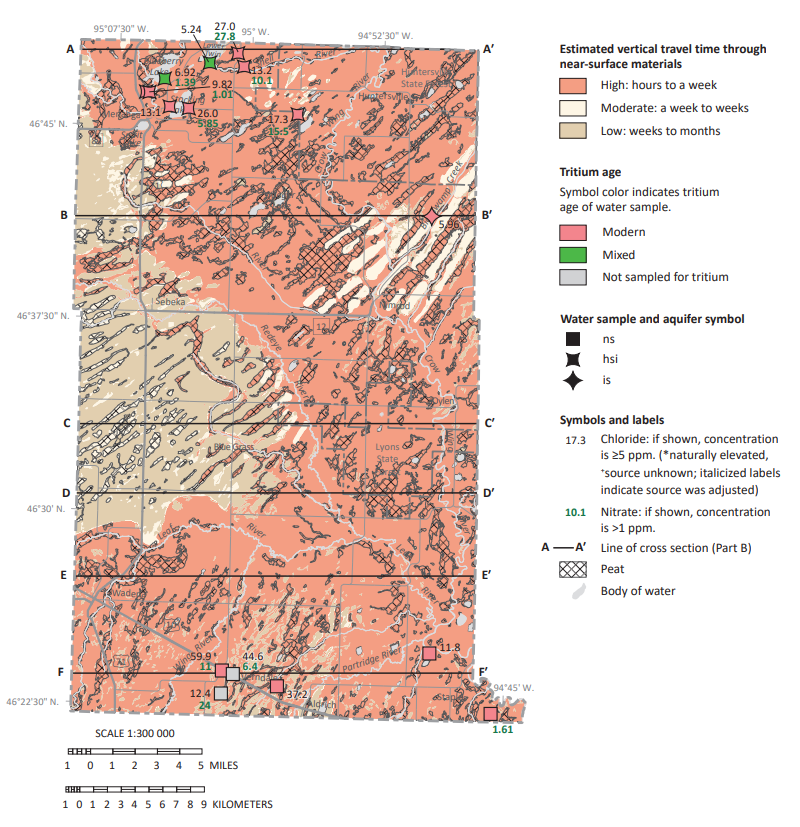 Wadena Pollution Sensitivity Map: In much of Wadena County, where areas of sandy outwash and alluvial deposits are common, pollution sensitivity of near-surface materials is high, with vertical estimated travel times of hours to a week. Samples from surficial sand aquifers contained modern or mixed tritium-age water, and anthropogenic chloride or nitrate were common.
How to See the Wadena Atlas
Free Workshop about Wadena County Atlas
The DNR will conduct a public workshop with information about the findings of this atlas from 1-4 p.m. Monday, Nov. 18 at the Wadena County Courthouse, 415 Jefferson Street South in Wadena. Registration is not required. Contact DNR Hydrogeologist Scott Pearson with questions at 651-259-5720.
More about groundwater atlas efforts
To learn more about the County Groundwater Atlas program, visit the Groundwater Atlas Program webpage. A status map of published and planned atlases is also available.
Funding for groundwater atlas efforts:

Funding for this project was provided by the Minnesota Environment and Natural Resources Trust Fund as recommended by the Legislative-Citizen Commission on Minnesota Resources (LCCMR).
The Trust Fund is a permanent fund constitutionally established by the citizens of Minnesota to assist in the protection, conservation, preservation, and enhancement of the state’s air, water, land, fish, wildlife, and other natural resources.
|
|
Currently 40% of net Minnesota State Lottery proceeds are dedicated to growing the Trust Fund and ensuring future benefits for Minnesota’s environment and natural resources.
|
|
|
 |
|
The National Flood Insurance Program (NFIP) has now had over 30 extensions since the last five-year extension that expired Sept. 30, 2017. The latest extension was set to expire Sept. 30, 2024, but on Sept. 26 the NFIP’s authorization was extended to Dec. 20, 2024.
FEMA's Congressional Reauthorization for the NFIP page should have the latest updates. FEMA reports that they and Congress have never failed to honor the flood insurance contracts in place with NFIP policyholders. Should the NFIP’s authorization lapse, FEMA would still have authority to ensure the payment of valid flood claims with available funds.
|
|
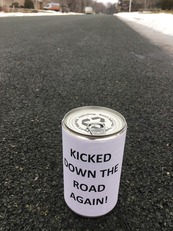 |
Should the authorization lapse, however, FEMA would stop selling and renewing policies for millions of properties in communities across the nation. Nationwide, the National Association of Realtors estimated in 2017 that a lapse might impact approximately 40,000 home sale closings per month. |
|
 |

Note: This is an update of the July and August 2024 Water Talk articles
On June 28, 2024, President Biden declared a Public Assistance (PA) disaster for 22 Minnesota counties. On July 29, 2024, Individual Assistance (IA) was added for 19 counties. Additional counties had PA and IA added on Aug. 21, Aug. 27 and Sept. 13, so there are now 21 Minnesota counties declared for both PA and IA and 11 declared for PA only. See the map below which shows counties with PA or both PA and IA declarations.
The incident period is June 16 to July 4, 2024.
Public Assistance (PA)
The PA counties include Blue Earth, Carver, Cass, Cook, Cottonwood, Faribault, Fillmore, Freeborn, Goodhue, Jackson, Lake, Le Sueur, Murray, Nobles, Pipestone, Rice, Rock, St. Louis, Steele, Wabasha, Waseca and Watonwan. On Aug. 21, Brown, Martin, McLeod, Redwood and Renville counties were added.
Public Assistance (PA) involves reimbursements to local communities for costs associated with emergency response and debris removal, in addition to repairs to public infrastructure like roads, utilities and public buildings. Minnesota's Homeland Security Emergency Management (HSEM) staff and county Emergency Managers have been working together with local officials to document damages, and FEMA staff have started to assist local governments with the recovery process.
|
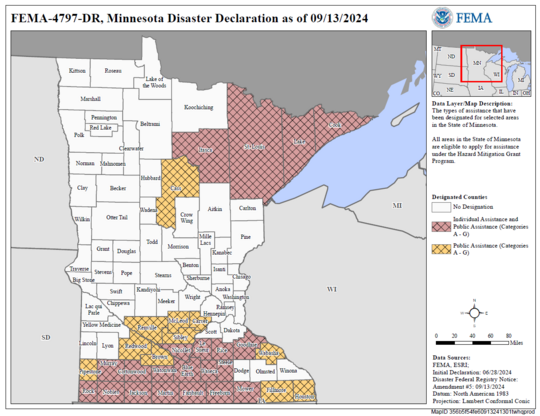 Individual Assistance (IA)
The following counties were included in the Individual Assistance (IA) declaration: Blue Earth, Cook, Cottonwood, Faribault, Freeborn, Goodhue, Itasca, Jackson, Lake, Le Sueur, Mower, Nicollet, Nobles, Rice, Rock, St. Louis, Steele, Waseca and Watonwan. On Sept. 13, Martin and Murray counties were added.
Individual Assistance makes resources available for homes and businesses. One of the main forms of assistance is Small Business Administration (SBA) loans, but there are some grants available for limited repairs, temporary housing and related assistance. See FEMA's Individual Assistance page for more details.
FEMA has had Disaster Recovery Centers (DRCs) in the declared counties where individuals can go to learn about options for assistance in one place, but most of those have now been closed.
The fastest way to apply is through DisasterAssistance.gov. You can also apply through the FEMA mobile app or by calling the FEMA Helpline at 800-621-3362.
Note that IA is not declared in Minnesota very often.
For more information about declarations

Are you interested in joining the DNR Ecological and Water Resources Division? The division is looking to fill a Floodplain Engineer position in our floodplain and shoreland management programs.
The position will be part of a dedicated team that works with FEMA to create and update quality floodplain models and maps that help Minnesotans understand flood risk. Job duties will include a mix of hydrology and hydraulics modeling, GIS tasks and database management, in addition to outreach to local communities during the mapping update process.
To apply, go to https://mn.gov/mmb/careers/ and search for “Floodplain Engineer.”
This posting is expected to re-open in early October 2024, and the closing date is anticipated to be late October 2024.
|
FEMA Region 5 staff (based in Chicago) are continuing their monthly one-hour virtual training series in 2024. They are free!
It's not too late to register for many training topics!
Upcoming "Managing your Community's Floodplain" monthly series dates and topics:

Note: All held 9-10 a.m. Central Time.
-
Oct. 30, 2024: Great Lakes Coastal Floodplain Management; Register
-
Nov. 27, 2024: Natural and Beneficial Functions; Register
-
Dec. 18, 2024: Community Rating System; Register
These trainings and registration links are also available on the DNR Floodplain Training and Education page.
|

Talk with FEMA and DNR Floodplain Program representatives during monthly virtual Minnesota Floodplain Management Office Hours. Hours are 10-11 a.m., typically on the fourth Thursday of the month (but a few are adjusted to avoid holidays, etc.).
Upcoming monthly hours (Note: all are 10 - 11 a.m. Central Time)
Where: Teams. No registration is required. Select a date to see a Teams meeting and join us.
These office hour dates and links are also available on the DNR Floodplain Training and Education page.
|
Important Dates to Note:
(since August 2024 Water Talk and upcoming in next couple months)
|
|
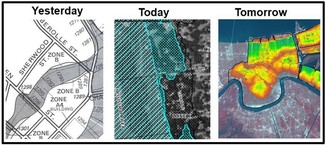 |
Preliminary Maps
None
Local Officials Meetings and Open Houses
None
90-Day Appeal Periods
None
Letters of Final Determination (LFDs)
- Sept. 11, 2024 - Itasca Countywide
- Sept. 25, 2024 - St. Louis Countywide
Effective (Six months after LFD date)
- March 11, 2025 - Itasca Countywide
- March 25, 2025 - St. Louis Countywide
Additional Map Update Information:
|